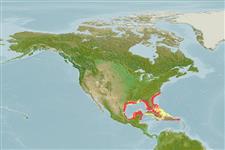Environment: milieu / climate zone / depth range / distribution range
Ecology
Marine; reef-associated; non-migratory; depth range 2 - 92 m (Ref. 9710), usually 5 - 25 m (Ref. 9761). Subtropical; 35°N - 18°N, 100°W - 64°W (Ref. 55264)
Western Atlantic: Bermuda, Bahamas and off southern Florida, USA to the Gulf of Mexico, including Yucatan, Mexico (Ref. 26938).
Size / Weight / Age
Maturity: Lm ? range ? - ? cm
Max length : 45.0 cm TL male/unsexed; (Ref. 4858); common length : 35.0 cm TL male/unsexed; (Ref. 3797)
Soft parts of dorsal and anal fins and caudal fins have wide yellow margins. Dark spot on forehead lacks electric blue ring. Juveniles blue, banded, with last prominent band straight (Ref. 26938). The pectorals are blue basally, clear distally, with a broad yellow band separating the two colors; the pelvic fins are light yellow (Ref. 13442).
Inhabits rocky or coral reefs (Ref. 9710). Juveniles in channels and on inshore reefs (Ref. 9710). Feeds primarily on sponges (Ref. 9710). Small juveniles do well in aquariums once they begin to accept food.
Life cycle and mating behavior
Maturity | Reproduction | Spawning | Eggs | Fecundity | Larvae
Allen, G.R., 1985. Butterfly and angelfishes of the world. Vol. 2. 3rd edit. in English. Mergus Publishers, Melle, Germany. (Ref. 4858)
IUCN Red List Status (Ref. 130435: Version 2024-1)
Threat to humans
Reports of ciguatera poisoning (Ref. 30303)
Human uses
Fisheries: minor commercial; aquarium: commercial
Tools
Can't connect to MySQL database fbquizv2. Errorcode: Too many connections
